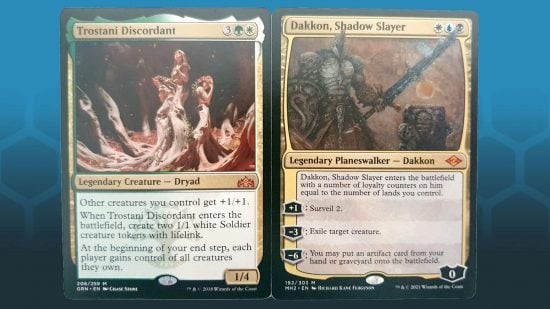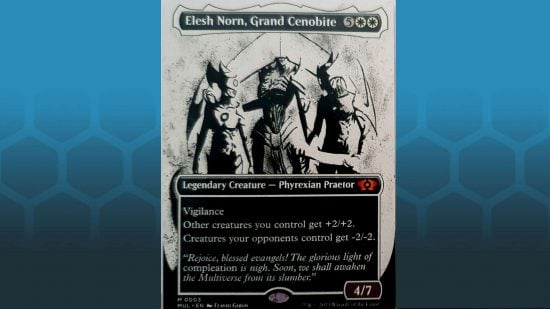MTG card rarity symbols represent how frequently each Magic: The Gathering card is printed in a set. There are four MTG rarities every player should know – common (C), uncommon (U), rare (R), and mythic rare (M or MR). This MTG card rarity guide will explain what each of these means, plus how rarity relates to a card’s appearance and value.
We’ll take a brief look at the history of MTG sets in order to understand where rarity comes from. The rules knowledge below can also help with building some MTG Arena decks.
Here’s everything you need to know about Magic card rarities:
- How to identify MTG card rarity
- What do Magic card rarities mean?
- MTG card rarity distribution
- Special Magic rarities
- Does MTG card rarity affect value?
- Does MTG card rarity affect power?
- MTG card rarity history

How to identify MTG card rarity
You can identify Magic Card rarities based on the color of its set symbol.
| MTG rarity | Set symbol color |
| Mythic rare | Orange |
| Rare | Gold |
| Uncommon | Silver |
| Common | Black |
The rarity is also printed as a letter following the card’s set number, at the bottom of the card. Old MTG sets may be missing either or both of these features, in which case you’ll need to search on Gatherer to identify the card rarity.
What do Magic card rarities mean?
MTG card rarity tells us how often a card appears in a booster pack. As we already mentioned, there are four basic rarities:
- Common (C)
- Uncommon (U)
- Rare (R)
- Mythic rare (M or MR)

Common
Every pack you open will include multiple commons. They’re the cards you’re most likely to toss in a drawer and ignore, but they can also have a huge impact, particularly in Limited games. They’re also the only card rarity that’s legal in the Pauper MTG format.
Uncommon
Uncommons are a little more complex than common cards, and they often pack more of a punch. It’s not often that you see an uncommon that’s stronger than rare and mythic rare cards, but it does happen – and you’ll probably have plenty of these cards in your deck, anyway.
Rare
Not all rare cards are complex, but all of them offer significant power levels. This might be in the form of beefy creatures or board wipes. If you want your deck to be competitive, chances are you’ll have plenty of these in play. They’re also a popular first pick when cracking packs during an MTG draft.
Mythic rare
Many MTG planeswalkers, and plenty of other high-power cards, are in the mythic rare category. These are the rarest of the rare, with a small set amount printed each set, so even less impressive cards that sport this simple can be worth money.

MTG card rarity distribution
The number of cards within Magic booster packs, and how many of each rarity type, has changed over the years. Today there are multiple types of booster pack for each set, each with a different distribution of cards. For example, here’s how draft boosters differ from play boosters:
Draft boosters
| Card rarity | Number in pack |
| Common | 10 |
| Uncommon | 3 |
| Rare or mythic rare | 1 |
One in every 7.4 draft booster packs contains a mythic rare instead of a regular rare, according to an article by lead designer Mark Rosewater. Although you’re less likely to get a mythic rare at all in a booster, each mythic rare is only half as common as each rare, because far fewer unique mythic rares are printed for each set. Draft booster packs also contain one basic land and one slot that may be either a foil card (of any rarity) or a token.
Play boosters
| Card rarity | Number in pack |
| Common | 6 |
| Uncommon | 3 |
| Rare or mythic rare | 1 |
Play boosters also include a basic land, plus two ‘wildcards’ that can have any rarity symbol. There’s a 12.5% chance you’ll get a mythic rare, and the wildcards mean you could end up bagging multiple rares.
In 2023, Mark Rosewater shared some statistics for play boosters on his blog, stating that there’s a 37% chance your booster will contain two rares or mythic rares. There’s also a 4% chance of getting three, and less than 1% chance that you’ll nab four.

Special Magic rarities
There are several special Magic rarities in the trading card game, too. Once upon a time, there was even a purple rarity symbol for special rarity cards. These were only ever used for timeshifted cards in the 2006 Time Spiral set.
These days, Magic: The Gathering also features additional rarity symbols that indicate a card’s type rather than their distribution. These are:
- MTG lands (L)
- Special cards (S)
- Tokens (T)
Beyond the official symbols, you’ll also find other kinds of Magic cards with different levels of rarity. For example:
Art treatment rarity
Many Magic cards are printed with multiple different ‘treatments’; for example, a basic version, an alternate art version, plus foil versions of both of those.
The relative scarcity of these different treatments is not considered part of the card’s rarity. However, some art treatments of cards can be staggeringly rare.
The most extreme example of this is the One of One Ring. It’s a variant of the mythic rare One Ring card from the Lord of the Rings: Tales of Middle Earth set, with text in elvish, and a serial number marking it as 001 of 001 copies ever printed. MTG fan and musician Post Malone bought it for $2 million.

Bonus sheet rarity
Several MTG sets have contained a ‘bonus sheet’ of thematically appropriate reprint cards, which can be used in limited games but aren’t considered part of the set for other purposes – they don’t become part of the MTG Standard rotation if they’re printed in a Standard-legal set. This began with the Mystical Archive in Strixhaven: School of Mages.
If a set has a bonus sheet, each draft booster contains one bonus sheet card. The community consensus is that in every 15 packs, 10 will contain an uncommon bonus sheet card, four will contain a rare, and one will contain a mythic rare.
The List
One in four set boosters contains a card from ‘The List’. This is a curated and periodically updated list of previously-printed MTG cards. According to Mark Rosewater, “commons, uncommons, rares, and mythic rares” on the list can be found “at the proper rate to one another”.
These cards are printed as if they were a card from an old set, using the same art, card frame, text, and set symbol. A small planeswalker symbol in the bottom left corner indicates that the card comes from the list.

Does MTG card rarity affect value?
A rare MTG card is not always an expensive MTG card. Two main factors drive the cost of cards: collector appeal, and demand from competitive players.
Hidetsugu, Devouring Chaos was a rare card printed in Kamigawa: Neon Dynasty. The basic version of the card is essentially worthless: it’s just not a very good card in competitive magic. Five different neon ink treatments of the card, with variant art, were printed. The rarest neon red version of the card is worth over $1,000.
Deadly Dispute was a common card printed in Adventures in the Forgotten Realms and Commander Masters: Battle for Baldur’s Gate. It sees play in Commander, Pioneer, and Pauper. At around $2 it doesn’t have a crazy high price, but still costs more than most rare cards printed in each new set.
Does MTG card rarity affect power?
Rarer Magic cards tend to be more complex, and this often means they’re more powerful. However, in such a complex TCG, things are rarely simple.
There are many, many cases when a common is a better pull than an MTG rare. Perhaps that common is a powerful card in its own right, like Lightning Bolt. Or perhaps that common sets up an excellent combo for your deck.

MTG card rarity history
In the early days of Magic, there were no rares or mythic rares. The first booster packs included six commons and two uncommons. Rares were first introduced in 1996’s Mirage set, and Time Spiral introduced the super rare timeshifted cards (though these were never printed outside of the set).
Before 1998, commons, uncommons, and rares all shared the same color set symbol. The Exodus set introduced different-colored symbols, and MTG rarity symbols were used on all cards going forward.
A whole decade later, the first mythic rare was printed in Shards of Alara.
The distribution of different rarities has changed many times over the years, most recently with the 2024 Murders at Karlov Manor set. This saw the debut of the play booster, which gives you the chance to pull multiple rares from a single pack.
If all this talk of rare cards has made you anxious, check out our guide to MTG Arena codes, where you can unlock some free booster packs (and hopefully some wildcards). Or do what an increasing number of people do, and build an MTG Commander deck – it’s a lot less painful to buy that mythic rare when you only need one copy.
